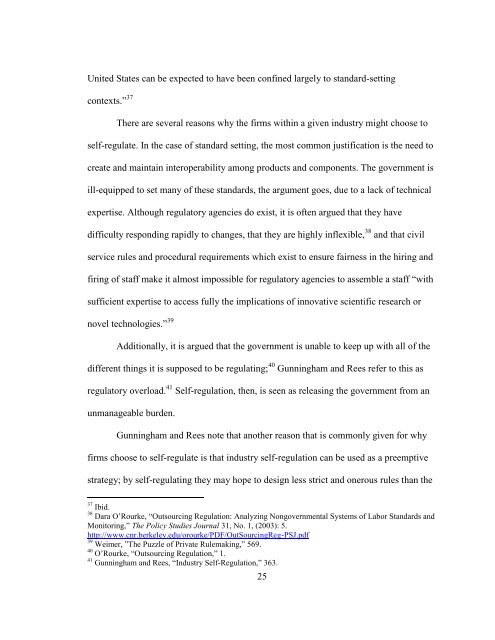Shifting Alliances in the Accreditation of Higher Education: On the ...
Shifting Alliances in the Accreditation of Higher Education: On the ...
Shifting Alliances in the Accreditation of Higher Education: On the ...
Create successful ePaper yourself
Turn your PDF publications into a flip-book with our unique Google optimized e-Paper software.
United States can be expected to have been conf<strong>in</strong>ed largely to standard-sett<strong>in</strong>g<br />
contexts.‖ 37<br />
There are several reasons why <strong>the</strong> firms with<strong>in</strong> a given <strong>in</strong>dustry might choose to<br />
self-regulate. In <strong>the</strong> case <strong>of</strong> standard sett<strong>in</strong>g, <strong>the</strong> most common justification is <strong>the</strong> need to<br />
create and ma<strong>in</strong>ta<strong>in</strong> <strong>in</strong>teroperability among products and components. The government is<br />
ill-equipped to set many <strong>of</strong> <strong>the</strong>se standards, <strong>the</strong> argument goes, due to a lack <strong>of</strong> technical<br />
expertise. Although regulatory agencies do exist, it is <strong>of</strong>ten argued that <strong>the</strong>y have<br />
difficulty respond<strong>in</strong>g rapidly to changes, that <strong>the</strong>y are highly <strong>in</strong>flexible, 38 and that civil<br />
service rules and procedural requirements which exist to ensure fairness <strong>in</strong> <strong>the</strong> hir<strong>in</strong>g and<br />
fir<strong>in</strong>g <strong>of</strong> staff make it almost impossible for regulatory agencies to assemble a staff ―with<br />
sufficient expertise to access fully <strong>the</strong> implications <strong>of</strong> <strong>in</strong>novative scientific research or<br />
novel technologies.‖ 39<br />
Additionally, it is argued that <strong>the</strong> government is unable to keep up with all <strong>of</strong> <strong>the</strong><br />
different th<strong>in</strong>gs it is supposed to be regulat<strong>in</strong>g; 40 Gunn<strong>in</strong>gham and Rees refer to this as<br />
regulatory overload. 41 Self-regulation, <strong>the</strong>n, is seen as releas<strong>in</strong>g <strong>the</strong> government from an<br />
unmanageable burden.<br />
Gunn<strong>in</strong>gham and Rees note that ano<strong>the</strong>r reason that is commonly given for why<br />
firms choose to self-regulate is that <strong>in</strong>dustry self-regulation can be used as a preemptive<br />
strategy; by self-regulat<strong>in</strong>g <strong>the</strong>y may hope to design less strict and onerous rules than <strong>the</strong><br />
37<br />
Ibid.<br />
38<br />
Dara O‘Rourke, ―Outsourc<strong>in</strong>g Regulation: Analyz<strong>in</strong>g Nongovernmental Systems <strong>of</strong> Labor Standards and<br />
Monitor<strong>in</strong>g,‖ The Policy Studies Journal 31, No. 1, (2003): 5.<br />
http://www.cnr.berkeley.edu/orourke/PDF/OutSourc<strong>in</strong>gReg-PSJ.pdf<br />
39<br />
Weimer, ‖The Puzzle <strong>of</strong> Private Rulemak<strong>in</strong>g,‖ 569.<br />
40<br />
O‘Rourke, ―Outsourc<strong>in</strong>g Regulation,‖ 1.<br />
41<br />
Gunn<strong>in</strong>gham and Rees, ―Industry Self-Regulation,‖ 363.<br />
25




![[Sample B: Approval/Signature Sheet] - George Mason University](https://img.yumpu.com/21978828/1/190x245/sample-b-approval-signature-sheet-george-mason-university.jpg?quality=85)


![[Sample B: Approval/Signature Sheet] - George Mason University](https://img.yumpu.com/18694905/1/190x245/sample-b-approval-signature-sheet-george-mason-university.jpg?quality=85)





![[Sample B: Approval/Signature Sheet] - George Mason University](https://img.yumpu.com/18694552/1/189x260/sample-b-approval-signature-sheet-george-mason-university.jpg?quality=85)


![[Sample B: Approval/Signature Sheet] - George Mason University](https://img.yumpu.com/18694474/1/190x245/sample-b-approval-signature-sheet-george-mason-university.jpg?quality=85)